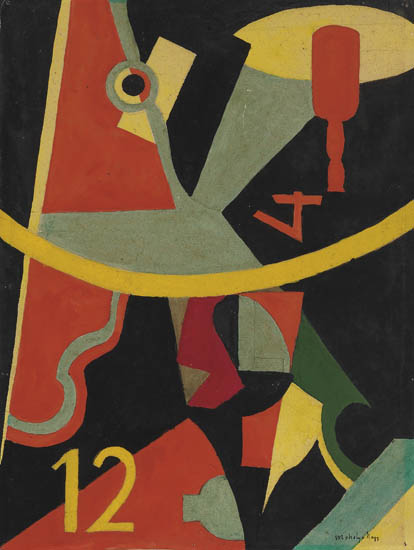Sale 2322 - Lot 375
Price Realized: $ 95,000
Price Realized: $ 118,750
?Final Price Realized includes Buyer’s Premium added to Hammer Price
Estimate: $ 40,000 - $ 60,000
LÁSZLÓ MOHOLY-NAGY
Composition.
Gouache and watercolor on paper. 335x225 mm; 13 1/4x8 7/8 inches. Signed in pen and black ink, lower right recto. Ex-collection Joan Daves; thence to the current owner.
Joan Daves (1919-1997) was an esteemed literary agent whose clientele included an array of Nobel Prize recipients, notably Hermann Hesse, Heinrich Böll, Elias Canetti, and Dr. Martin Luther King, Jr. Daves began her career at Harper & Brothers, where in the 1940s she collaborated with Mrs. Mohology-Nagy while compiling a book regarding Moholy-Nagy art career.
Moholy-Nagy (1894-1946) was an influential Jewish-Hungarian artist known for his vast range of contributions to art and design--particularly to the Bauhaus in Germany. Born László Weisz, Moholy-Nagy changed his surname after his father abandoned his family; Nagy derived from his mother's friend, a Christian lawyer who supported the family after his father left, and Moholy comes from the region where his family home was located, called Mohol. Initially Moholy-Nagy was interested in writing, he published his own poems and prose from the age of 13, and continued to be active in writing for contemporary avant-garde publications in Hungary.
In 1914, soon after he entered Budapest University to study law, he was drafted into the Hungarian army where he sustained a serious injury in battle and, while recovering in the military hospital, he began drawing on military-issued postcards. By the time he was discharged from the army in 1918 he had completed 400 drawings on postcards. Moholy-Nagy completed his law degree, with no intention of practicing professionally, and continued his art education with the avant-garde Fauvist artist Robért Borény.
In 1919, he left Hungary for Vienna and in 1920 continued on to Berlin where in 1923 he became an instructor at the Bauhaus. It is likely that this particular gouache was made just before he began his tenure at the Bauhaus. The stylistic components are consistent with other works from this period, for example his Large Railway Painting, 1920, now in the Thyssen-Bornemisza Collection, Madrid, which contains similar numerical and geometric elements as the ones represented in the gouache. Around 1920, Moholy-Nagy was still producing works in the Cubist mode by integrating outlines of recognizable forms and alpha-numerals into his works--elements that he would soon abandon. Influences from the various expressionist movements centered in Berlin, particularly Russian Constructivism, Futurism and Dadaism are also present in his works from this time.
As he began his new role as instructor in the Bauhaus, he became more focused on photography and new technology, adopting the Bauhaus emphasis on artistic versatility and the integration of art and design. Moholy-Nagy believed that photography presented a new way of seeing the world that the naked eye was not capable of--he summed up his theories and teachings in his groundbreaking book The New Vision, from Material to Architecture, 1938.
After leaving the Bauhaus in 1928, Moholy-Nagy created his famous kinetic sculpture--a work that deftly combines design and technology--which became known as the "Light-Space Modulator." When World War II struck Berlin in 1933, Moholy-Nagy was forced to uproot and moved to Holland, then London, and finally to Chicago in 1937. During his movements through Europe he worked freelance and contributed to large design projects that focused on innovative technology and design, widely spreading his name and reputation. In Chicago, with the support of American Industrialist Walter Paepcke, he attempted to start an American Bauhaus school. The first attempt failed due to a lack of financial backing but his second attempt, the Institute of Design, succeeded is now part of Illinois Institute of Technology.
Composition.
Gouache and watercolor on paper. 335x225 mm; 13 1/4x8 7/8 inches. Signed in pen and black ink, lower right recto. Ex-collection Joan Daves; thence to the current owner.
Joan Daves (1919-1997) was an esteemed literary agent whose clientele included an array of Nobel Prize recipients, notably Hermann Hesse, Heinrich Böll, Elias Canetti, and Dr. Martin Luther King, Jr. Daves began her career at Harper & Brothers, where in the 1940s she collaborated with Mrs. Mohology-Nagy while compiling a book regarding Moholy-Nagy art career.
Moholy-Nagy (1894-1946) was an influential Jewish-Hungarian artist known for his vast range of contributions to art and design--particularly to the Bauhaus in Germany. Born László Weisz, Moholy-Nagy changed his surname after his father abandoned his family; Nagy derived from his mother's friend, a Christian lawyer who supported the family after his father left, and Moholy comes from the region where his family home was located, called Mohol. Initially Moholy-Nagy was interested in writing, he published his own poems and prose from the age of 13, and continued to be active in writing for contemporary avant-garde publications in Hungary.
In 1914, soon after he entered Budapest University to study law, he was drafted into the Hungarian army where he sustained a serious injury in battle and, while recovering in the military hospital, he began drawing on military-issued postcards. By the time he was discharged from the army in 1918 he had completed 400 drawings on postcards. Moholy-Nagy completed his law degree, with no intention of practicing professionally, and continued his art education with the avant-garde Fauvist artist Robért Borény.
In 1919, he left Hungary for Vienna and in 1920 continued on to Berlin where in 1923 he became an instructor at the Bauhaus. It is likely that this particular gouache was made just before he began his tenure at the Bauhaus. The stylistic components are consistent with other works from this period, for example his Large Railway Painting, 1920, now in the Thyssen-Bornemisza Collection, Madrid, which contains similar numerical and geometric elements as the ones represented in the gouache. Around 1920, Moholy-Nagy was still producing works in the Cubist mode by integrating outlines of recognizable forms and alpha-numerals into his works--elements that he would soon abandon. Influences from the various expressionist movements centered in Berlin, particularly Russian Constructivism, Futurism and Dadaism are also present in his works from this time.
As he began his new role as instructor in the Bauhaus, he became more focused on photography and new technology, adopting the Bauhaus emphasis on artistic versatility and the integration of art and design. Moholy-Nagy believed that photography presented a new way of seeing the world that the naked eye was not capable of--he summed up his theories and teachings in his groundbreaking book The New Vision, from Material to Architecture, 1938.
After leaving the Bauhaus in 1928, Moholy-Nagy created his famous kinetic sculpture--a work that deftly combines design and technology--which became known as the "Light-Space Modulator." When World War II struck Berlin in 1933, Moholy-Nagy was forced to uproot and moved to Holland, then London, and finally to Chicago in 1937. During his movements through Europe he worked freelance and contributed to large design projects that focused on innovative technology and design, widely spreading his name and reputation. In Chicago, with the support of American Industrialist Walter Paepcke, he attempted to start an American Bauhaus school. The first attempt failed due to a lack of financial backing but his second attempt, the Institute of Design, succeeded is now part of Illinois Institute of Technology.

Exhibition Hours
Exhibition Hours
Aliquam vulputate ornare congue. Vestibulum maximus, libero in placerat faucibus, risus nisl molestie massa, ut maximus metus lectus vel lorem.


